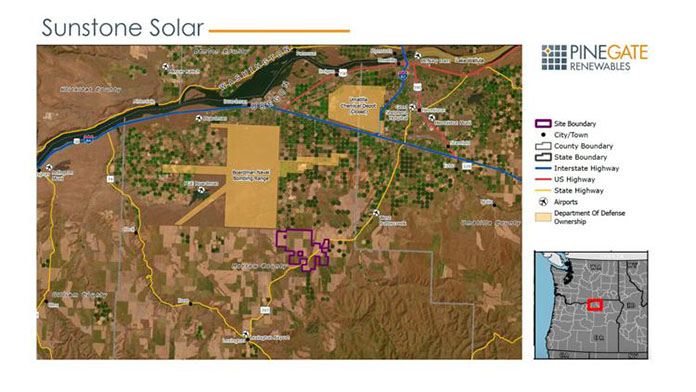Initial steps have been taken to provide Morrow County with a solar power facility expected to supply 600 jobs and enough clean energy to power more than 200,000 homes.
Logan Stephens, Pine Gate Renewables senior director of development, said the North Carolina-based company on June 30 filed its preliminary paperwork with the Oregon Department of Energy and Energy Facilities Siting Council. He said the company wants to install a solar energy and energy storage facility southeast of the Boardman naval bombing range.
“Essentially, this is the first step in getting our application for that site certificate put together,” he said. “So we filed it and we expect to go back and forth with the Department of Energy, who is going to be seeking input from other stakeholders at the state and local levels throughout the process to get to a final application, which we anticipate toward the end of this year, early next year.”
Stephens said the filing kicked off a 12- to 18-month review process with opportunities for public engagement expected in 2024.
“The first half or so of that is just going back and forth to get to a final application,” he said. “After that there will be opportunities for public input and participation in the process before the Energy Facilities Siting Council makes a determination on whether or not to approve the certificate.”
The project, named Sunstone Solar, is expected to produce approximately 1,200 megawatts of electricity.
“We estimate that it will generate enough energy every year to power the equivalent of over 200,000 average Oregon homes. That’s the easiest way to think about it,” he said.
Stephens said the facility would include millions of individual solar panels, racking equipment, converters, transformers and other electrical components to generate electricity and send it to existing power lines.
“The maximum footprint of the facility that we are seeking to get permitted with the Department of Energy is little over 10,000 acres,” he said. “By the time the final plant design is optimized, it could be less than that.”
According to the company, development for the project began in 2021 and will end in 2026, which is when construction is expected to start. Stephens said the project should provide about 600 jobs.
“The sort of head count of construction workers on site has a little bit of a ramp-up and ramp-down shape to it as you might imagine, but we anticipate the peak to be around 600 folks who will be on site for a period of three to four years as we fill the different phases of the facility,” he said. “And those jobs are made of a variety of different disciplines whether it’s day laborer or electricians or simple contractors and folks for the mechanical install of the racking system and everything.”
He added that some jobs would remain after the facility’s completion.
“There will be a few related to the maintenance of the facility, and we will have a few onsite facilities for operation and maintenance, but it will certainly be a lot less, maybe 10 or 20 or 30, but we don’t have an exact number on that,” Stephens said. “We are still in the planning phase, but the bulk of the job creation is for the construction phase.”
The company states the facility is expected to be fully operational in 2030.
Stephens said the project’s cost would depend on market conditions at the time of construction, but estimated it could be anywhere from $1 billion to $5 billion.
He also said no public funds would be used to construct the site and that the county would receive an estimated $8.4 million annually via a payment in lieu of tax or PILOT agreement with Pine Gate.
“This provides some certainty around the revenues the county can expect to see from the facility over the first 17 years, which is the term of the agreement,” Stephens said. “And that amount is $7,000 per megawatt, which is the maximum amount allowed in Oregon. So once the facility is fully operational with all phases online, that will represent $8.4 million of revenue through the PILOT agreement with the county.”
After the PILOT agreement expires, the facility would be taxed under normal rates, he said.
Stephens also said the Umatilla Electric Cooperative and Bonneville Power Administration have signed interconnection and transmission agreements with Pine Gate. He said UEC will build facilities to accept the power from the site onto its systems. He said BPA is involved because at the other end of the UEC line there is a BPA substation that needs an interconnection to protect BPA equipment.
According to Pine Gate, it will later establish an agreement with an “offtaker,” a company that will purchase the solar power.
Once complete, Stephens said, the facility could potentially bring down energy prices for the offtaker’s customers. “We expect that the ultimate partners who will be signing the agreements to purchase the power will be doing so because it’s cost-competitive for their needs, and solar combined with energy storage is one of the lowest cost forms of energy available in today’s market.”
Pine Gates states that it doesn’t control prices the customers pay because that is dependent on the company that buys the energy and how it integrates the energy into its pricing.
However, Stephens said the solar project should help the state meet its clean energy goals in a low-cost, affordable and reliable way.
“Some of the other benefits we hope to bring to the area include the tax revenues,” he said, “… along with the economic development opportunities to provide those construction jobs, workforce training opportunities and help enable continued growth in the Morrow County area.”











